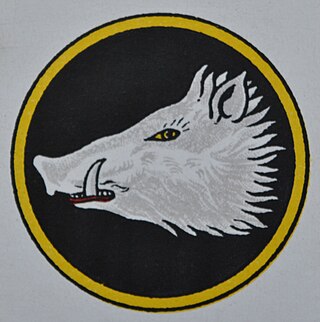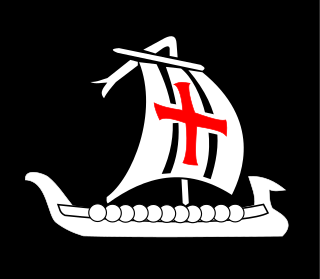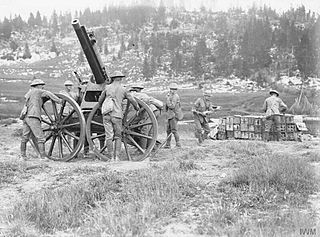| XIX Corps | |
|---|---|
 XIX Corps formation badge. | |
| Active | World War I |
| Country | |
| Branch | |
| Type | Field corps |
| Part of | Second Army |
| Engagements | World War I [1] |
The British XIX Corps was a British infantry corps during World War I.
| XIX Corps | |
|---|---|
 XIX Corps formation badge. | |
| Active | World War I |
| Country | |
| Branch | |
| Type | Field corps |
| Part of | Second Army |
| Engagements | World War I [1] |
The British XIX Corps was a British infantry corps during World War I.
British XIX Corps was formed in France in February 1917 and fought at the Battle of Passchendaele in Autumn 1917. [1] In Spring 1918 it was driven back 20 miles in five days and found itself in disarray. [2] By November 1918 the Corps, as an element of Second Army, was one of the most northerly British military formations in France. [3]
Prior to the armistice, the corps was on the Second Army's left, with the 41st Division on the left, 35th in the centre and 31st on the right. It was composed of the following units, the 35th Division having been transferred from the II Corps on 3 November 1918: [3]
Commanders included:
The British Expeditionary Force (BEF) was the six divisions the British Army sent to the Western Front during the First World War. Planning for a British Expeditionary Force began with the 1906–1912 Haldane Reforms of the British Army carried out by the Secretary of State for War Richard Haldane following the Second Boer War (1899–1902).

The 10th (Irish) Division, was one of the first of Kitchener's New Army K1 Army Group divisions, authorized on 21 August 1914, after the outbreak of the Great War. It included battalions from the various provinces of Ireland. It was led by Irish General Bryan Mahon and fought at Gallipoli, Salonika and Palestine. It was the first of the Irish Divisions to take to the field and was the most travelled of the Irish formations. The division served as a formation of the United Kingdom's British Army during World War I.

The 12th (Eastern) Division was an infantry division raised by the British Army during the First World War from men volunteering for Kitchener's New Armies. The division saw service in the trenches of the Western Front from June 1915 to the end of the war.

The 14th (Light) Division was an infantry division of the British Army, one of the Kitchener's Army divisions raised from volunteers by Lord Kitchener during the First World War. All of its infantry regiments were originally of the fast marching rifle or light infantry regiments, hence the title "Light". It fought on the Western Front for the duration of the First World War.
The division was disbanded by March 1919, and was not reformed in the Second World War.
The 27th Division was an infantry division of the British Army raised during the Great War, formed in late 1914 by combining various Regular Army units that had been acting as garrisons about the British Empire. The division spent most of 1915 on the Western Front in France before moving to Salonika where it remained with the British Salonika Army for the duration of the war. In 1916 its commander Hurdis Ravenshaw was captured by an Austrian submarine whilst sailing to England. In 1918 in Salonika the division took part in the Battle of Doiran. It carried out occupation duties in the Caucasus in the post-war before being withdrawn from the region in 1919.

The 7th Infantry Division was an infantry division of the British Army, first established by The Duke of Wellington as part of the Anglo-Portuguese Army for service in the Peninsular War, and was active also during the First World War from 1914 to 1919, and briefly in the Second World War in 1939.

The 18th (Eastern) Division was an infantry division of the British Army formed in September 1914 during the First World War as part of the K2 Army Group, part of Lord Kitchener's New Armies. From its creation the division trained in England until 25 May 1915 when it landed in France and spent the duration of the First World War in action on the Western Front, becoming one of the elite divisions of the British Army. During the Battle of the Somme in the latter half of 1916, the 18th Division was commanded by Major General Ivor Maxse.

The 31st Division was an infantry division of the British Army. It was raised in the Great War by volunteers from Kitchener's Army and formed in April 1915 as part of the K4 Army Group and taken over by the War Office on 10 August 1915. Comprising mainly infantry battalions from Yorkshire and Lancashire, the division was sent to Egypt in December 1915 before moving to France in March 1916 and spent the remainder of the First World War in action on the Western Front. The 31st Division was the quintessential New Army division, being made up entirely of Pals battalions.

The Fourth Army was a field army that formed part of the British Expeditionary Force during the First World War. The Fourth Army was formed on 5 February 1916 under the command of General Sir Henry Rawlinson to carry out the main British contribution to the Battle of the Somme.

The 32nd Division was an infantry division of the British Army that was raised in 1914, during the First World War. The division was raised from volunteers for Lord Kitchener's New Armies, made up of infantry 'Pals battalions' and artillery brigades raised by public subscription or private patronage. The division was taken over by the War Office in September 1915. It served in France and Belgium in the trenches of the Western Front for the duration of the war. It saw action at the Battle of the Somme, the Pursuit to the Hindenburg Line, the Defence of Nieuport, the German spring offensive, and the Allied Hundred Days Offensive beginning at the Battle of Amiens. After the Armistice it marched into Germany as part of the Army of Occupation.

The 41st Division was an infantry division of the British Army, raised during the First World War as part of Lord Kitchener's New Armies. The division saw service on the Western Front and later on the Italian Front.

The 19th (Western) Division was an infantry division of the British Army, part of Kitchener's Army, formed in the Great War.

42nd Brigade was an infantry formation of the British Army during both World Wars. It was formed in August 1914 as part of Kitchener's Army, and was assigned to the 14th (Light) Division, serving on the Western Front. It was reformed in World War II for line of communication and deception purposes. As 42 Brigade it became a regional headquarters from 1982 to 2017.
The Sixth Army was a field army of the French Army during World War I and World War II.

The Fifth Battle of Ypres, also called the Advance in Flanders and the Battle of the Peaks of Flanders is an informal name used to identify a series of World War I battles in northern France and southern Belgium (Flanders) from late September to October 1918.

V Corps was an army corps of the British Army that saw service in both the First and the Second World Wars. It was first organised in February 1915 and fought through the First World War on the Western front. It was recreated in June 1940, during the Second World War and was substantially reorganised in 1942 for participation in Operation Torch. It fought through the Tunisia Campaign and later the Italian Campaign.

The 35th Infantry Division was an infantry division of the British Army, raised during World War I as part of General Kitchener's fourth New Army. Its infantry was originally composed of Bantams, that is soldiers who would otherwise be excluded from service due to their short stature. The division served on the Western Front from early 1916, and was disbanded in 1919.

The 57th Division was an infantry formation of the Territorial Force created in 1914 as part of the massive expansion of the British Army during the First World War. It served on the Western Front during 1917 and 1918. The divisional number was reactivated for deception purposes during the Second World War.

During World War I, both Britain and France sent military forces to Italy in October 1917.
The 35th Indian Brigade was an infantry brigade of the British Indian Army that saw active service with the Indian Army during the First World War. It took part in the Mesopotamian campaign and was disbanded shortly after the end of the war. It was not reformed for the Second World War.